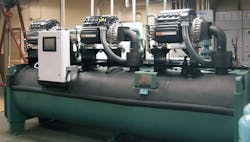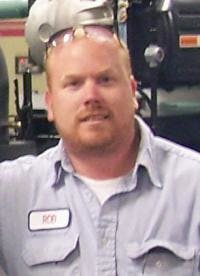Large Tonnage Chiller Service, Then & Now
Thinking back to the early days in my career, every service call I took with “the boss” was memorable, yet somewhat similar. We’d arrive at the facility, exchange some light-hearted greetings and have a few quiet words with the customer. Then, I would watch as my mentor, a master mechanic, walked up and evaluated the machine.
In those days, machine controls were electro-mechanical, and feedback information to the operator wasn’t as forthcoming as chiller control panels of today. Therefore, it took a special talent to read, interpret, and then explain what the machine was “telling” us.
With slow, methodical movements, I would watch as he would touch and feel the machine in various places. At first, I thought this evaluation process looked rather strange, almost mythical. There were no radical tools, infrared thermometers, digital manifold gauges or other such tools available; just raw knowledge of the machine, its internal construction, and the way auxiliary systems influenced operation. The boss’s analysis was based on three pressure gauges and the temperatures he felt.
For a chiller to run properly, so many systems had to work in conjunction with each other in just the right way. It was like magic, tuning what couldn’t be seen or sometimes measured.
As the machine reacted to some abstract condition, I would watch intently as a small screw driver appeared, and the smallest of adjustments on a particular control corrected the issue, and what had been nervous vibrations became harmonious, as the system came back into tune. You could feel the difference just by standing on the floor.
As we drove away, I couldn’t help but admire the boss’s skill and ability that frankly, was difficult to comprehend. For a chiller to run properly, so many systems had to work in conjunction with each other in just the right way. It was like magic, tuning what couldn’t be seen or sometimes measured — all on a behemoth piece of equipment that many of my friends didn’t even know existed. It looked so easy, yet I understood even then it would take many years of experience and knowledge to reach that level of competency.
Only years later did I come to understand that the scheduled work I was asked to perform on the same machine during the next planned shutdown was the result of that visit, and most likely the customer and my boss had already discussed the issue prior to our arrival.
20 Years Later
With the machines of today, things are very different, but the experience doesn’t have to be. Water chillers are increasingly complex, and although the fundamentals are the same, technology and efficiency-focused designs have changed the way chillers operate. For the most part, the majority of their complexity comes from the auxiliary systems needed to support centrifugal compression at prolonged light load turn down; this is where most of the energy efficiency benefits are realized.
For the most part, the majority of their complexity comes from the auxiliary systems needed to support centrifugal compression at prolonged light load turn down.
The way industry approaches the evolution of smart controls often presents challenges far beyond fluid flow dynamics of performance. Technicians today need to be well versed in refrigeration principles, mechanical drive train designs, the effects of changing water flows, control architectures that often require laptop interface, building automation systems knowledge, and overall system understanding.
The challenge is to cover all of these principles with variable flow and energy efficiency routines coming from different schools of thought, which leave a particular system without measurable constants. Professional design engineers have a large part to play in the overall intent of a given design, but most systems these days are variable-speed moving targets, and the chiller specialist is often responsible for tuning and obtaining harmony without sacrificing comfort or production, while protecting the chiller from damage.
Constant Speed, Fixed Set Points
In times past, most chillers ran at a constant speed, with a fixed set of flow and temperature set points. Under these circumstances, we came to expect what a chiller would do under a given set of conditions depending on how long the unit ran at that performance point.
For example: If a constant speed machine’s running amps was 40% of full load design, we could expect a 2-4 degree temperature difference on the evaporator and condenser. We would expect that the inlet guide vanes were most likely closed. We could expect that we were providing 30% of the chillers capacity to the process load.
Most systems these days are variable-speed moving targets, and the chiller specialist is often responsible for tuning and obtaining harmony without sacrificing comfort or production, while protecting the chiller from damage.
From experience, we understood that if the unit spent a considerable time at this condition, we might eventually lose oil to the evaporator and end up with low-end surge and lost efficiency. Because the water flows are constant, we could look at refrigerant approach temperatures and ascertain fairly quickly if oil entrained refrigerant was responsible for the ill effects.
Everything is ‘Variable’
On newer machines, everything is variable. To meet demand, compressor motor speed is driven by elaborate variable frequency drives working in conjunction with the inlet guide vanes. Variable metering devices feed refrigerant to the evaporator based on external inputs. Movable discharge diffusers stabilize the impeller wheel. Variable speed oil pumps ramp is dependent on pressure. All of those are working in conjunction with variable chilled and condenser water flows that for the most part are reacting to building load, that couldn’t care less about chiller condition.
And in the middle of this system is the compressor. It can be a challenge to protect it from surge or choke conditions and their adverse effects. Given the same base load situation above, it would be likely to find a machine operating much differently under a variable speed scenario.
For example: a chiller is running at 25% KW output. Inlet guide vanes are fully open, motor speed is 2 Hz above minimum speed, chilled water delta temperature is 10, and condenser water temperature delta is 10, chilled water pump speed is 42 Hz, condenser pump speed is 48 Hz, two cells of tower fans are at 37 Hz, we have a narrow approach on the evaporator and condenser, yet the compressor is experiencing surging.
This can be very difficult condition to diagnose. Is there a problem with the compressor? Are we not getting our oil back? Do we have a refrigerant charge issue? Are the unit controls not set up correctly? Are the multiple control systems not tuned together? Are the rate of changes too quick? Are we under/over flowing the heat exchangers?
Lift is the difference between discharge and suction pressure. Discharge superheat has to do with the warmth of the vapor is as it exits the compressor.All of these factors come into play, and even the most seasoned chiller technician can have difficulty identifying and solving the problem. All the customer knows is that the chiller isn’t maintaining temperature, is making bad sounds, and you’ve been dispatched to fix it. Luckily for technicians, thanks to centrifugal compression there’s still one constant at which we can start our analysis: machine lift and discharge superheat. Lift is the difference between discharge and suction pressure. Discharge superheat has to do with the warmth of the vapor is as it exits the compressor. Each machine, regardless of design, has to obey the laws of lift and discharge superheat. If we focus on these two constants we have the best chance of maintaining a healthy operational envelope, and we can successfully solve problems rather than chase symptoms and likely make the problem worse. During an evaluation, the large compressor deserves attention, but the auxiliary systems will tell you the most about the machine. Lift has direct influence on inverter cooling systems, motor cooling systems, oil cooling systems, purge units, intermediate pressures and economizer flows, and more.Observe and Learn Learn, understand and document these systems routinely. A problem will most likely manifest itself in one of these systems before it affects the entire machine. Observe and pay attention to the little things to help ensure a healthy chiller. For the young people that are coming into the trade and reaching new levels of competency and experience, take the time to thank your mentors for the opportunity they’ve given you. This is a fantastic industry with lots to offer, and every day is a learning experience. As technology evolves, who else will be able to meet this challenge? A successful project is one that everyone who is involved in it can explain to someone else, so, try to keep it simple. Every system is unique and for those reasons, I like to think that “Chillers are People Too.”

